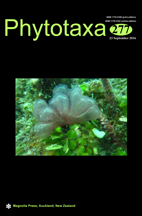Abstract
Gibsmithia hawaiiensis is a peculiar red alga characterized by furry gelatinous lobes arising from a cartilaginous stalk. The species has been recorded from tropical reef systems throughout the Indo-Pacific. A multilocus phylogeny (UPA, rbcL, COI-5P) of 36 specimens collected throughout the species distribution range, showed high genetic diversity at species level. Two major groups were identified, each consisting of multiple lineages. Genetic variability was low in the Hawaiian Islands and the northern Red Sea and high in the Western Indian Ocean and the Coral Triangle, where lineages overlap in distribution. Genetic distances suggest that G. hawaiiensis represents a complex of five cryptic species, with no difference observed in the external morphology corresponding to separate lineages. Anatomical and reproductive differences were observed at the microscopic level for the lineage from the Red Sea, which is here described as G. eilatensis sp. nov. The geographic range of the species complex is here expanded to include Madagascar, the Red Sea and the Indo-Malay region, and the generitype seems endemic to the Hawaiian Islands. Algal diversity on coral reef systems is discussed from a conservation perspective using G. hawaiiensis as an example.

